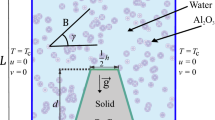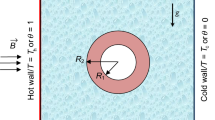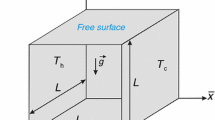Abstract
MHD mixed convection heat transfer and entropy generation analysis for Cu–water nanofluid inside two interacting open cavities are numerically investigated. The right and the left walls of each cavity are heated or cooled at uniform but different heat flux densities. The nanofluid flow is described by the Buongiorno model in order to take into account the thermophoresis effect and the Brownian motion. The governing equations are solved using the finite volume method with the SIMPLE algorithm. The effects of relevant parameters including the Hartmann number (Ha), the Richardson number (Ri), the opening ratio (R), the heat flux ratio (Rq) and the nanoparticles volume fraction (ϕi) are analyzed. The results show that the flow pattern resulting from the simultaneous action of the magnetic field and the buoyancy force is heightened by the decrease in Ha and R and the increase in Ri and Rq. The heat transfer, which evolves in a non-monotonous way with the Hartmann number, is enhanced by the rise of the Richardson number, the heat flux ratio and the nanoparticles volume fraction, as well as by the reduction in the opening ratio. It is also observed that, overall, the thermodynamic disorder is dominated by the thermal irreversibility which decreases at high Ha with the augmentations of Ri and ϕi and the reductions in R and Rq.
















Similar content being viewed by others
Abbreviations
- B 0 :
-
Magnetic induction (T)
- C p :
-
Specific heat at constant pressure (J kg−1 K−1)
- d :
-
Cavity opening width
- d f :
-
Molecule diameter of the base fluid (m)
- d p :
-
Nanoparticle diameter (m)
- D B :
-
Brownian diffusion coefficient (m2 s−1)
- D T :
-
Thermophoretic diffusion coefficient (m2 s−1 K−1)
- Ec :
-
Eckert number
- g :
-
Gravitational acceleration (m s−2)
- H :
-
Channel width (m)
- Ha :
-
Hartmann number
- k :
-
Thermal conductivity (W m−1 K−1)
- k B :
-
Boltzmann’s constant (J K−1)
- ℓ :
-
Channel length (m)
- Le :
-
Lewis number
- N B :
-
Brownian motion parameter
- Ns :
-
Entropy generation number
- N T :
-
Thermophoresis parameter
- Nu :
-
Nusselt number
- p :
-
Pressure (Pa)
- Pr :
-
Prandtl number
- q :
-
Heat flux density (W m−2)
- R :
-
Opening ratio
- Re :
-
Reynolds number
- Ri :
-
Richardson number
- R q :
-
Heat flux ratio
- s :
-
Source width
- S :
-
Total entropy generation
- \(S^{{{\prime \prime \prime }}}\) :
-
Local entropy generation (W m−3 K−1)
- T :
-
Temperature (K)
- T fr :
-
Freezing point of the base fluid (K)
- u :
-
Axial velocity (m s−1)
- v :
-
Transverse velocity (m s−1)
- w :
-
Adiabatic zone width (m)
- x :
-
Axial coordinate (m)
- y :
-
Transverse coordinate (m)
- α :
-
Irreversibility ratio
- β :
-
Thermal expansion coefficient (K−1)
- θ :
-
Dimensionless temperature
- μ :
-
Viscosity (kg m−1 s−1)
- ρ :
-
Density (kg m−3)
- ϑ :
-
Channel volume (m3)
- ϕ :
-
Nanoparticles volume fraction
- δ :
-
Irreversibility coefficient
- c:
-
Cooled
- f:
-
Base fluid
- Frt:
-
Fluid friction
- h:
-
Heated
- i:
-
Inlet
- m:
-
Mean
- Mag:
-
Hydromagnetic
- nf:
-
Nanofluid
- p:
-
Nanoparticles
- Th:
-
Thermal
- W:
-
Wall
References
Mousavi SS, Hooman K. Heat and fluid flow in entrance region of a channel with staggered baffles. Energy Convers Manag. 2006;47:2011–9. https://doi.org/10.1016/j.enconman.2005.12.018.
Wu W, Ching CY. Laminar natural convection in an air-filled square cavity with partitions on the top wall. Int J Heat Mass Transf. 2010;53:1759–72. https://doi.org/10.1016/j.ijheatmasstransfer.2010.01.014.
Deng QH, Zhou J, Mei C, Shen YM. Fluid, heat and contaminant transport structures of laminar double-diffuse mixed convection in a two-dimensional ventilated enclosure. Int J Heat Mass Transf. 2004;47:5257–69. https://doi.org/10.1016/j.ijheatmasstransfer.2004.06.025.
Bahlaoui A, Raji A, Hasnaoui M, Naimi M, Makayssi T, Lamsaadi M. Mixed convection cooling combined with surface radiation in a partitioned rectangular cavity. Energy Convers Manag. 2009;50:626–35. https://doi.org/10.1016/j.enconman.2008.10.001.
Naphon P, Nakharintr L, Wiriyasart S. Continuous nanofluids jet impingement heat transfer and flow in a micro-channel heat sink. Int J Heat Mass Transf. 2018;126:924–32. https://doi.org/10.1016/j.ijheatmasstransfer.2018.05.101.
Choi SUS. Enhancing thermal conductivity of fluids with nano-particles. Trans ASME J Heat Transf. 1995;66:99–105.
Rashidi S, Mahian O, Languri EM. Applications of nanofluids in condensing and evaporating systems: a review. J Therm Anal Calorim. 2018;131:2027–39. https://doi.org/10.1007/s10973-017-6773-7.
Rashidi S, Karimi N, Mahian O, Esfahani JA. A concise review on the role of nanoparticles upon the productivity of solar desalination systems. J Therm Anal Calorim. 2019;135:1145–59. https://doi.org/10.1007/s10973-018-7500-8.
Mahian O, Kolsi L, Amani M, Estellé P, Ahmadi G, Kleinstreuer C, Marshall JS, Siavashi M, Taylor RA, Niazmand H, Wongwises S, Hayat T, Kolanjiyil A, Kasaeian A, Pop I. Recent advances in modeling and simulation of nanofluid flows-part I: fundamental and theory. Phys Rep. 2019;790:1–48. https://doi.org/10.1016/j.physrep.2018.11.004.
Mahian O, Kolsi L, Amani M, Estellé P, Ahmadi G, Kleinstreuer C, Marshall JS, Taylor RA, Abu-Nada E, Rashidi S, Niazmand H, Wongwises S, Hayat T, Kasaeian A, Pop I. Recent advances in modeling and simulation of nanofluid flows-part II: applications. Phys Rep. 2019;791:1–59. https://doi.org/10.1016/j.physrep.2018.11.003.
Rashidi S, Eskandarian M, Mahian O, Poncet S. Combination of nanofluid and inserts for heat transfer enhancement: gaps and challenges. J Therm Anal Calorim. 2019;135:437–60. https://doi.org/10.1007/s10973-018-7070-9.
Sourtiji E, Hosseinizadeh SF, Gorji-Bandpy M, Ganji DD. Effect of water-based Al2O3 nanofluids on heat transfer and pressure drop in periodic mixed convection inside a square ventilated cavity. Int Comm Heat Mass Transf. 2011;38:1125–34. https://doi.org/10.1016/j.icheatmasstransfer.2011.05.009.
Mehrizi AA, Farhadi M, Afroozi HH, Sedighi K, Darz AAR. Mixed convection heat transfer in a ventilated cavity with hot obstacle: effect of nanofluid and outlet port location. Int Comm Heat Mass Transf. 2012;39:1000–8. https://doi.org/10.1016/j.icheatmasstransfer.2012.04.002.
Mehrez Z, Bouterra M, El Cafsi A, Belghith A. Heat transfer and entropy generation analysis of nanofluids flow in an open cavity. Comput Fluids. 2013;88:363–73. https://doi.org/10.1016/j.compfluid.2013.09.026.
Mohammed HA, Alawi OA, Wahid MA. Mixed convective nanofluids flow in a channel having backward-facing step with a baffle. Powder Technol. 2015;275:329–43. https://doi.org/10.1016/j.powtec.2014.09.046.
Fazeli H, Madani S, Mashaei PR. Nanofluid forced convection in entrance region of a baffled channel considering nanoparticle migration. Appl Therm Eng. 2016;106:293–306. https://doi.org/10.1016/j.applthermaleng.2016.06.010.
Mashaei PR, Taheri-Ghazvini M, Shabanpour Moghadam R, Madani S. Smart role of Al2O3-water suspension on laminar heat transfer in entrance region of a channel with transverse in-line baffles. Appl Therm Eng. 2017;112:450–63. https://doi.org/10.1016/j.applthermaleng.2016.10.061.
Mashaei PR, Hosseinalipour SM, Bagheri N, Taheri-Ghazvini M, Madani S. Simultaneous effect of staggered baffles and dispersed nanoparticles on thermal performance of a cooling channel. Appl Therm Eng. 2017;120:748–62. https://doi.org/10.1016/j.applthermaleng.2017.03.142.
Siavashi M, Yousofvand R, Rezanejad S. Nanofluid and porous fins effects on natural convection and entropy generation of flow inside a cavity. Adv Powder Technol. 2018;29:142–56. https://doi.org/10.1016/j.apt.2017.10.021.
Sheremet MA, Roşca NC, Roşca AV, Pop I. Mixed convection heat transfer in a square porous cavity filled with a nanofluid with suction/injection effect. Comput Math Appl. 2018;76:2665–77. https://doi.org/10.1016/j.camwa.2018.08.069.
Rashidi S, Esfahani JA. The effect of magnetic field on instabilities of heat transfer from an obstacle in a channel. J Magn Magn Mater. 2015;391:5–11. https://doi.org/10.1016/j.jmmm.2015.04.095.
Bovand M, Rashidi S, Esfahani JA, Masoodi R. Control of wake destructive behavior for different bluff bodies in channel flow by magnetohydrodynamics. Eur Phys J Plus. 2016;131:194. https://doi.org/10.1140/epjp/i2016-16194-3.
Rashidi S, Bovand M, Esfahani JA. Application of magnetohydrodynamics for suppressing the fluctuations in the unsteady flow around two side-by-side circular obstacles. Eur Phys J Plus. 2016;131:423. https://doi.org/10.1140/epjp/i2016-16423-9.
Rashidi S, Esfahani JA, Maskaniyan M. Applications of magnetohydrodynamics in biological systems-A review on the numerical studies. J Magn Magn Mater. 2017;439:358–72. https://doi.org/10.1016/j.jmmm.2017.05.014.
Mehrez Z, El Cafsi A, Belghith A, Le Quéré P. MHD effects on heat transfer and entropy generation of nanofluid flow in an open cavity. J Magn Magn Mater. 2015;374:214–24. https://doi.org/10.1016/j.jmmm.2014.08.010.
Chen CK, Chen BS, Liu CC. Entropy generation in mixed convection magnetohydrodynamic nanofluid flow in vertical channel. Int J Heat Mass Transf. 2015;91:1026–33. https://doi.org/10.1016/j.ijheatmasstransfer.2015.08.042.
Bondareva NS, Sheremet MA, Oztop HF, Abu-Hamdeh N. Heatline viualization of MHD natural convection in an inclined wavy open porous cavity filled with a nanofluid with a local heater. Int J Heat Mass Transf. 2016;99:872–81. https://doi.org/10.1016/j.ijheatmasstransfer.2016.04.055.
Sheremet MA, Oztop HF, Pop I. MHD natural convection in an inclined wavy cavity with corner heater filled with a nanofluid. J Magn Magn Mater. 2016;416:37–47. https://doi.org/10.1016/j.jmmm.2016.04.061.
Sheremet MA, Oztop HF, Pop I, Al-Salem K. MHD free convection in a wavy open porous tall cavity filled with nanofluids under an effect of corner heater. Int J Heat Mass Transf. 2016;103:955–64. https://doi.org/10.1016/j.ijheatmasstransfer.2016.08.006.
Abbaszadeh M, Ababaei A, Arani AAA, Sharifabadi AA. MHD forced convection and entropy generation of CuO-water nanofluid in a microchannel considering slip velocity and temperature jump. J Braz Soc Mech Sci Eng. 2016;39:775–90. https://doi.org/10.1007/s40430-016-0578-7.
Rashidi S, Bovand M, Esfahani JA. Opposition of magnetohydrodynamics and Al2O3-water nanofluid flow around a vertex facing triangular obstacle. J Mol Liq. 2016;215:276–84. https://doi.org/10.1016/j.molliq.2015.12.034.
Job VM, Gunakala SR. Mixed convection nanofluid flows through a grooved channel with internal heat generating solid cylinders in the presence of an applied magnetic field. Int J Heat Mass Transf. 2017;107:133–45. https://doi.org/10.1016/j.ijheatmasstransfer.2016.11.021.
Hussain S, Ahmed SE, Akbar T. Entropy generation analysis in MHD mixed convection of hybrid nanofluid in an open cavity with a horizontal channel containing an adiabatic obstacle. Int J Heat Mass Transf. 2017;114:1054–66. https://doi.org/10.1016/j.ijheatmasstransfer.2017.06.135.
Yousofvand R, Derakhshan S, Ghasem K, Siavashi M. MHD transverse mixed convection and entropy generation study of electromagnetic pump including a nanofluid using 3D LBM simulation. Int J Mech Sci. 2017;133:73–90. https://doi.org/10.1016/j.ijmecsci.2017.08.034.
Bovand M, Rashidi S, Esfahani JA. Optimum interaction between magnetohydrodynamics and nanofluid for thermal and drag management. J Therm Heat Transf. 2017;31:218–29. https://doi.org/10.2514/1.T4907.
Job VM, Gunakala SR. Unsteady hydromagnetic mixed convection nanofluid flows through an L-shaped channel with a porous inner layer and heat-generating components. Int J Heat Mass Transf. 2018;120:970–86. https://doi.org/10.1016/j.ijheatmasstransfer.2017.12.112.
Ma Y, Mohebbi R, Rashidi MM, Yang Z, Sheremet MA. Numerical study of MHD nanofluid natural convection in a baffled U-shaped enclosure. Int J Heat Mass Transf. 2019;130:123–34. https://doi.org/10.1016/j.ijheatmasstransfer.2018.10.072.
Akar S, Rashidi S, Esfahani JA, Karimi N. Targeting a channel coating by using magnetic field and magnetic nanofluids. J Therm Anal Calorim. 2019. https://doi.org/10.1007/s10973-018-7975-3.
Buongiorno J. Convective transports in nanofluids. Trans ASME J Heat Transf. 2006;128:240–50. https://doi.org/10.1115/1.2150834.
Corcione M. Empirical correlating equations for predicting the effective thermal conductivity and dynamic viscosity of nanofluids. Ener Conver Manage. 2011;52:789–93. https://doi.org/10.1016/j.enconman.2010.06.072.
Bejan A. Second-law analysis in heat transfer and thermal design. Adv Heat Transf. 1982;52:1–58. https://doi.org/10.1016/S0065-2717(08)70172-2.
Bejan A. Entropy generation minimization. Boca Taron: CRC Press; 1996.
Patankar SV. Numerical heat transfer and fluid flow. New York: Mc Graw-Hill; 1980.
Mahmoudi AH, Shahi M, Talebi F. Effect of inlet and outlet location on the mixed convective cooling inside the ventilated cavity subjected to an external nanofluid. Int Comm Heat Mass Transf. 2010;37:1158–73. https://doi.org/10.1016/j.icheatmasstransfer.2010.04.004.
Author information
Authors and Affiliations
Corresponding author
Additional information
Publisher's Note
Springer Nature remains neutral with regard to jurisdictional claims in published maps and institutional affiliations.
Rights and permissions
About this article
Cite this article
Fersadou, B., Kahalerras, H., Nessab, W. et al. Effect of magnetohydrodynamics on heat transfer intensification and entropy generation of nanofluid flow inside two interacting open rectangular cavities. J Therm Anal Calorim 138, 3089–3108 (2019). https://doi.org/10.1007/s10973-019-08343-0
Received:
Accepted:
Published:
Issue Date:
DOI: https://doi.org/10.1007/s10973-019-08343-0




